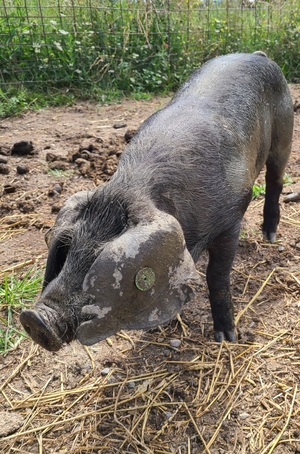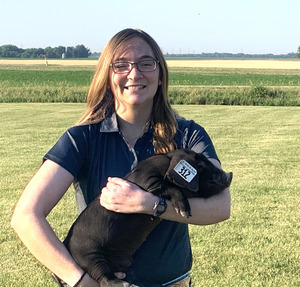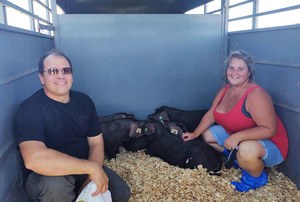



Landmark piglets ready to hog the spotlight
The first critically-endangered Large Black piglets bred from frozen, imported semen were born in the United States this summer.After years of extensive collaborative efforts from many organisations, new life and new genetics are being introduced to American Large Black Hog herds thanks to 25 half-British Large Black piglets born at Purdue University.

Solid black, deep-bodied swine with lop ears that cover their eyes, Large Blacks have long been prized for their docile nature, superior mothering abilities and succulent pork. Despite these qualities, the Large Black Hog is in global danger of extinction. Fewer than 150 purebred animals were registered in the United States in 2019. Through partnerships with breeders, universities, private donors, USDA, industry leaders and food organisations, The Livestock Conservancy is working to save this unique breed for future farming generations.
Small populations, like the Large Black, can quickly lose genetic diversity and suffer from inbreeding depression. This can lead to declines in fitness traits, including reproductive ability. To infuse new genetics into this US heritage swine population, The Livestock Conservancy imported frozen semen from two Large Black boars from the UK in 2015. Importation was made possible by a significant gift from an anonymous donor, several additional private donations, as well as partnerships with the USDA’s National Animal Germplasm Program (NAGP), Large Black Hog Association, Gloucestershire Old Spots America, British Pig Association, and Deerpark Pedigree Pigs of the UK.
The Livestock Conservancy and NAGP subsequently conducted inseminations during several on-farm trials. Despite efforts of the best swine reproduction specialists in the US and participating farmers who have worked with this breed for decades, none of these attempts produced live piglets. The experts soon realised heritage breed pig reproductive cycling is different from commercial pigs, where artificial insemination is common.

Dr Kara Stewart, assistant professor of Animal Sciences at Purdue University with a specialty in reproductive physiology, and graduate student Katharine Sharp, began exploring methods to control and synchronise ovulation of Large Black sows to identify ideal times for insemination. Thawed semen is only viable for a short time period, so predictable timing of ovulation and insemination is critical to the successful use of frozen semen. Twenty Large Black female pigs were donated to The Livestock Conservancy from breeders across the nation and were transported from their home farms to Purdue University in 2018 to launch this research.
"When I heard that The Livestock Conservancy was having trouble finding enough girls for this research project, I thought I would donate four sisters that were weaned and ready to go," said Felicia Krock, registrar and secretary of the Large Black Hog Association and a member of The Livestock Conservancy. "I thought if there were issues with the bloodline it would raise its ugly head through the use of three of my girls who were full siblings and one who was a half sibling to them. This was such a great opportunity to enhance the survivability of a very special breed."
For nearly two years, Purdue scientists studied female reproduction for the breed, first using less expensive frozen semen from US pigs to test their insemination protocols. The researchers refined a Large Black sow cycling protocol that allowed them to predict ovulation, thaw semen at just the right time, and inseminate the females. Each insemination trial at Purdue saw greater improvements in the rate of conception and number of live births. Pigs produced from these trials were used in further research projects to document growth and meat characteristics for the endangered breed.
The next, and most expensive, step was using the frozen, imported semen to create half-British and half-American piglets. The hard work paid off. Half-British piglets were born in May 2020 from five sows. The little boars and gilts are being distributed across the US to broaden the genetic base for the Large Black breed.

“Preservation of heritage breeds is important to help maintain the genetic diversity of our livestock,” said David Burgett, a member of both The Livestock Conservancy and the Large Black Hog Association, who recently received a few of the piglets at his Illinois farm. “Having dwindled to such a small population, the Large Black Hog, through years of inbreeding with the limited number of bloodlines available in the United States, was in danger of losing some of the diverse traits inherent to specific blood lines. With the importation of British bloodlines comes the responsibility to work together as members of the Large Black Hog Association to improve the herd, to promote the breed and the characteristics that make it unique and so desirable, and build the population back up to avoid its extinction. We are grateful that we had this chance to participate in the joint project with The Livestock Conservancy and Purdue University to improve the future, and promote the survival of the Large Black Hog.”
A second breeding with imported semen will be conducted this fall to produce more piglets. Researchers plan to share their research results and techniques with farmers, enabling them to do on-farm artificial insemination and produce their own Large Black breeding stock. These new techniques for using frozen semen on heritage breed pigs will allow Large Black boar semen to be more widely exchanged among the nation’s breeders to keep their herds genetically healthy. The new frozen semen protocols may be useful for other heritage pig breeds, as well.
The Livestock Conservancy’s Swine Initiative with Large Black pigs illustrates the power of collaboration and technology to advance rare breed conservation.
Click here to learn more about Large Black pigs.






